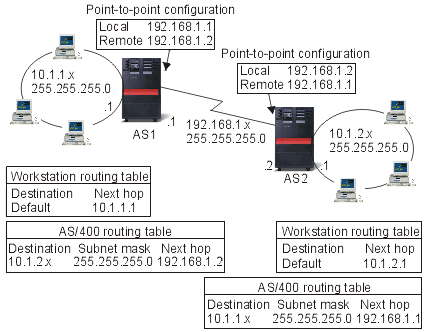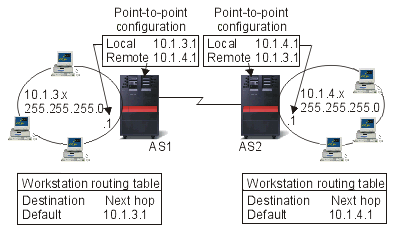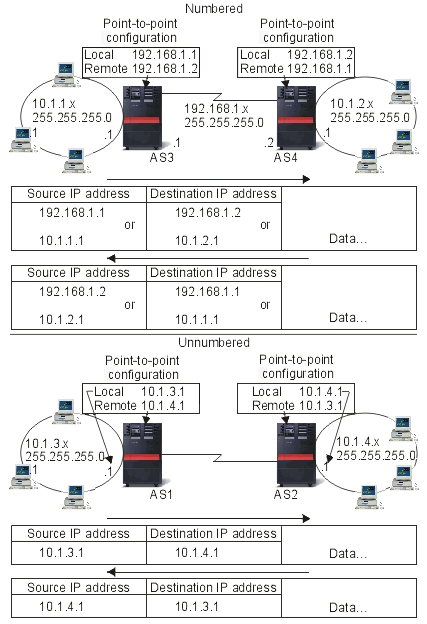You can get your data from your local system to a remote system or from a local network to a remote network with point-to-point connections. This explains two concepts used in configuring IP addresses for a point-to-point connection.
Point-to-point connections are typically used to connect two systems together over a wide area network (WAN). You can use a point-to-point connection to get data from your local system to a remote system or to get data from a local network to a remote network. Do not confuse point-to-point connections with Point-to-Point Protocol. Point-to-Point Protocol (PPP) is one type of a point-to-point connection that is commonly used to connect a computer to the Internet. See PPP connections for more information about how to set up and manage your PPP connections.
You can use point-to-point connections across dial-up lines, leased lines, and other types of networks such as frame relay. There are two ways that you can configure the IP addresses for a point-to-point connection: a numbered connection or an unnumbered connection. As the names imply, a numbered connection has a unique IP address defined for each interface. An unnumbered connection does not use additional IP addresses for a connection.
Numbered network connections
On the surface, it seems that the simplest way to configure a point-to-point connection is by using a numbered connection. A numbered connection is a point-to-point definition that has a unique IP address defined for each end of a connection.
Here are some points to keep in mind when you consider a numbered point-to-point connection:
- Each end of the connection has a unique IP address.
- Routing statements must be added to your system to flow the traffic to the remote system.
- Addresses on the point-to-point link must be managed by your network administrator.
- Addresses are used up just to connect two systems.
When each point-to-point connection is defined to your iSeries™ server, a routing entry must be made on each end to describe how to get to any network at the other end of the connection. The routing selection process on your iSeries server depends on having an IP address for each interface. These addresses and routes must be managed by your network administrator. In a small network, these addresses are easy to keep track of and do not use many additional addresses. In a large network, however, it might take an entire subnet of addresses just to define an interface at each end.
The following figure shows a numbered network connection between two iSeries servers. A routing entry is not needed if all you want to do is communicate from AS1 to AS2. If you want to communicate with systems in the remote network (10.1.2.x), the routing entry included in the figure must be added to each system. This is because the remote network,10.1.2.x, is a part of the 192.168.1.x connection.

Unnumbered network connections
An unnumbered connection is a more complex method of defining a point-to-point connection than a numbered connection. However, you might find the unnumbered connection a simpler and better way to manage your network.
The routing selection process in the iSeries server depends on having an IP address for an interface. In an unnumbered connection, the point-to-point interface does not have a unique address. The IP address of your iSeries server interface for an unnumbered connection is actually the IP address of the remote system.
Points to keep in mind while considering an unnumbered connection:
- The point-to-point interface has an address that appears to be in the remote network.
- Routing statements are not needed in the system.
- Your network administration is simplified by not using up IP addresses for the link.
In the following example, AS1 appears to have an interface in the 10.1.4.x network and AS2 appears to have an interface in the 10.1.3.x network. The AS1 is connected to LAN network 10.1.3.x with an address of 10.1.3.1. This allows AS1 to communicate with any system on the 10.1.3.x network directly.

Also shown in the example is AS2. AS2 is connected to LAN network 10.1.4.x with an address of 10.1.4.1. This allows AS2 to communicate with any system on the 10.1.4.x network directly. Each system (AS1 and AS2) adds the remote address to its routing table as a local interface. The address is treated specially so that packets destined for that address will not be processed locally. The packets for the remote address will be placed on the interface and transported to the other end of the connection. When the packet arrives at the other end of the connection, normal packet processing is used.
Now you have a need to connect AS1 to the 10.1.4.x network and to connect AS2 to the 10.1.3.x network. If these two systems were in the same room, you can simply add a LAN adapter to each system and plug the new interface into the correct LAN. If you did this, AS1 and AS2 would not need any routing entries added. In this example, however, the systems are in different cities so you must use a point-to-point connection. Even though you are using a point-to-point connection, you might still want to avoid adding routing entries. By defining the Point-to-Point Protocol (PPP) connection as an unnumbered connection, you achieve the same results that you can get if you use LAN adapters without adding any routing entries to your iSeries server. To do this, each system borrows the IP address of the remote system for use with route resolution.
Unnumbered versus numbered connection data flow
The following figure shows the addresses that will be used in a numbered and unnumbered point-to-point connection. The top half of the picture shows, that with a numbered connection, the remote system address of 192.168.1.2 or 10.1.2.1 could be used to reach the remote system. This is because there is a routing entry in AS3 that directs packets for 10.1.2.1 to 192.168.1.2 as the next hop. The addresses used in the return packet are based on the received packet. The bottom of the figure shows the addresses used with an unnumbered connection. The outbound packet has a source of 10.1.3.1 and a destination of 10.1.4.1. No routing entries are needed on either system because the systems have a direct interface to the remote network by using the remote system address of the point-to-point connection.
